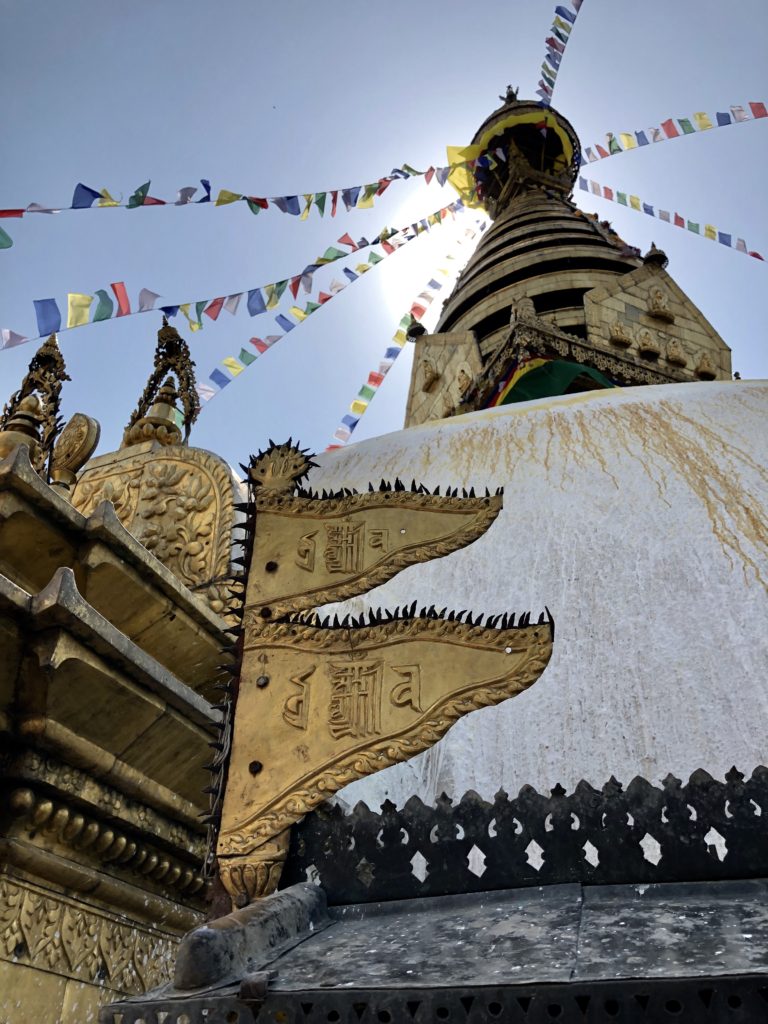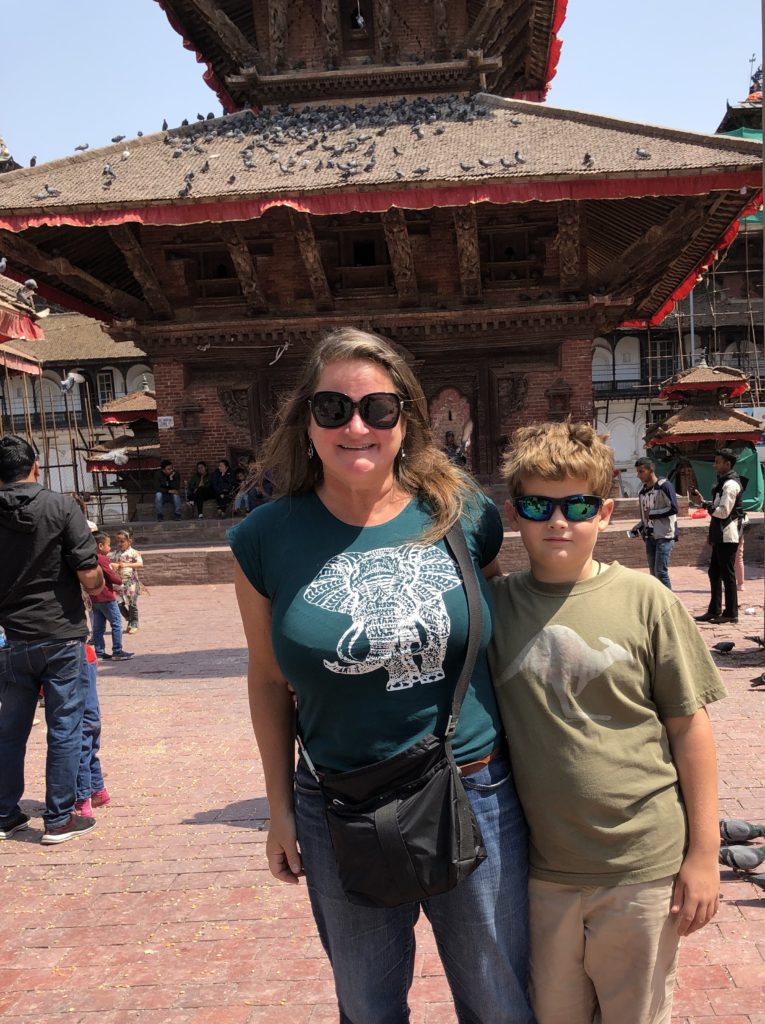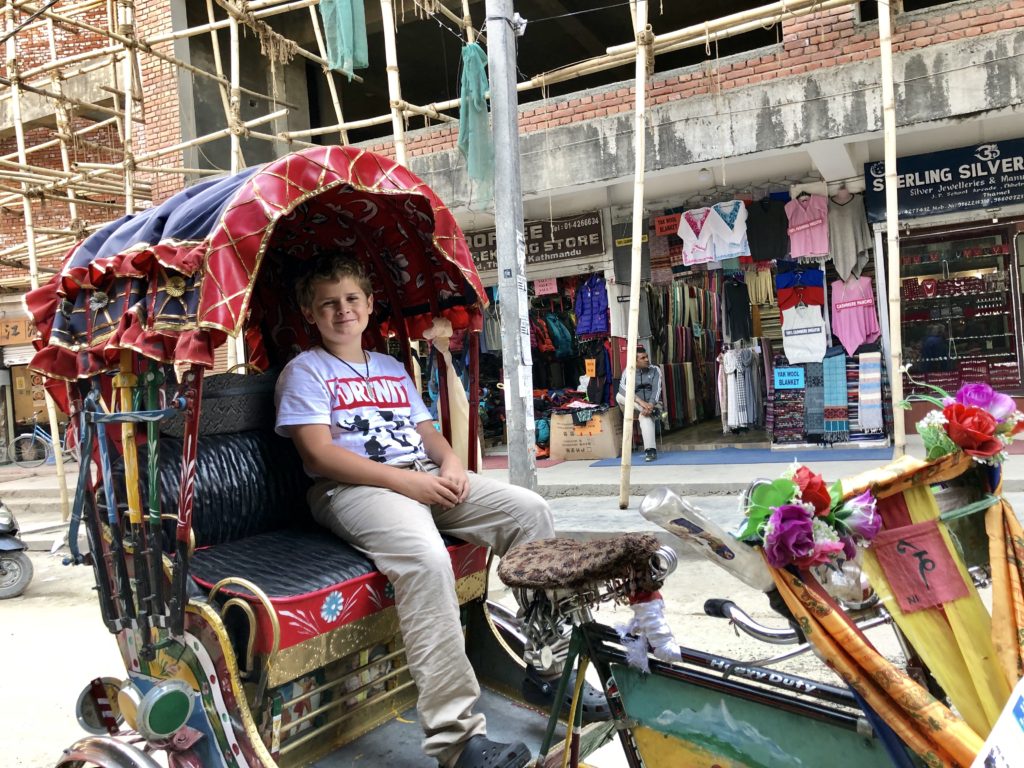When we arrived in Kathmandu, the smell of incense was everywhere in the street. I looked forward, so much, to revisiting Kathmandu. Even its name is so evocative, so exotic; what could Bob Seger’s experience of Kathmandu have been when he wrote that song, so long ago? So many books, so many journeys make note of Kathmandu. When I came here in 1992, felt like it was the wildest, craziest, most otherworldly place ever. Maybe because I was young, maybe because I had not yet seen so many places in the world, but it seemed medieval, mystical, holy. Tiny winding streets filled with impossible shops: butcher shops with hints of bloody meat, tailors hunched over their machines, old Tibetan women with elaborate nose-rings. And the chillum-smoking sadhus at Pashupatinath, the burning bodies, the ancient temples at Durbar Square; it is so crazy to be able to buy an airplane ticket and land in another world.
So I had many expectations, but also the fear that it all would have changed, that I would have changed. We arrived on the day of Holi, the festival of spring, the festival of colors. Young people smear one another with colors and water balloons, with lots of singing and dancing. It was a nice welcome, although we did not leave the Trekkers Home to join the revelry, as I might have done years ago.
And of course things have changed, but so have I. When I went for breakfast at the little coffeeshop next to the hostel, I was shocked to see the international edition of today’s New York Times. There are trekker supermarkets to help you stock up on upscale chocolate, gummy bears, Nalgene, trail mix, Chilean wine, anything you like. There are Thai restaurants and pizza places and Japanese restaurants, as might befit a cosmopolitan capital city. There are several North Face stores, and the prices are cheap; I paid $18 for a new pair of hiking pants. They say the stuff is fake; the label says Made in Bangladesh but it seems fine. And there are no plastic bags in Kathmandu! Bring your own bag or pay Rs.10 for a cloth bag!
We went to the iconic Boudhanath Stupa, one of the largest stupas in the world. It may be as old as 400 AD. All kinds of blessings are bestowed upon those who circumnavigate the stupa three times, in a clockwise direction. My little brochure calls it a “ wish-granting jewel, which automatically answers any entreaty and prayer that is made to it.”
Additionally, “All births in the lower rooms will be halted for any sentient being who prays and circumambulates this great stupa. Whoever hears mention of it will have placed the seed of enlightenment upon their mind stream. All of those who recall it, will be saved from fits of madness and paralysis and will gain and especially focus concentration. All those who filled their hands as a marker respect to it will come to the correct path. Whoever offers prostration in homage to it will take birth as a chakra/wielding monarch of a thousand world systems. All of those who circumambulate it will acquire the seven qualities of higher existences. whoever makes entreaties to it will effortlessly accomplish the two purposes.”
I thought it might be a good idea to ambulate the stupa with all of these blessings in mind, but Declan did not feel comfortable with me spinning the prayer wheels. “This is for Buddhists!” He grumbled. “You don’t believe this stuff; stop touching those!”
The area around Boudhanath is really a beautiful space, surrounded by old three and four-story buildings with rooftop restaurants. The shops below sold traditional gongs and singing bowls, crystals; there was a school for thanka arts. The area around Boudhanath has received an influx of Tibetan refugees with the Chinese takeover of Tibet. There are lots of schools and monasteries surrounding the stupa, which was rebuilt with international funds after the devastating 2015 earthquake in Nepal.
We took a colorfully decorated bicycle rickshaw to Durbar Square, which made such an impression on me all those years ago. It is the Royal Palace Square, and many of the buildings are from the 1400’s. Durbar Square suffered tremendous damage with the 2015 earthquake; they are starting to rebuild, but it is not the same. The Chinese government is paying for some of the restoration/reconstruction, but my guide tells me that much of the money gets siphoned off with corruption. We saw workers, squatting on piles of bricks, doing some of the painstaking work by hand. Some temples had been restored, which was good, but it seemed too new, too fake; the authenticity of the centuries had been stripped from it.
We went also to the “monkey temple”, or Swayambhunath Temple. The site has been around since the third century BCE, although the current structure was built around 600 CE. I read Peter Matthiessen’s “The Snow Leopard” while we were trekking, and is said that the Buddha himself did some teaching at Swayambhunath. The monkey temple is indeed surrounded by monkeys; apparently some 8000 monkeys live in the area. The monkeys are quite habituated to humans, of course; I found them drinking very expertly from water bottles discarded by tourists. Mohan, our guide on the trek, told us that sometimes the monkeys perch above the 300+ steps up to the stupa and urinate on unsuspecting tourists.
Coming back to Kathmandu after trekking, we checked in once again to the Trekkers Home. Declan, of course, just wanted to catch up on videos and Fortnite, but I really wanted to visit Pashupathinath, where Julie and I had visited so many years ago. I visited on April 14th, which turned out to be the Nepali New Year (year 2076!; Nepal is 56 years and 8 months ahead of the Common Era calendar). Pashupathinath was packed with devotees, and this time I had a guide. Declan declined to accompany me, so I felt like I had a limited time frame. The guide found me just outside the ticket booth, a one-armed man named Arjun. It was really nice to have a guide, with the crowds and the limited time frame. I remember meandering around a fairly empty temple complex when I was with Julie; today, there were crowds and an LED marquee displaying time and temperature, as well as advising foreigners that they were not permitted in the main temple.
But there were still the sadhus, the burning bodies, the temples. It turns out that “Pashupathinath” is an incarnation of Shiva as “lord of the animals”, so animals are everywhere. There is a huge great golden bull, or Nandi, and various other animal incarnations, and of course Shiva’s lingam, or phallus, in the smaller temples. There is a hospice for the dying, right next to the cremation ghats. There are houses of mourning for the families who come from far away, and people cook food every day for the monkeys, who are a sacred part of the complex.
There are the trekkers, there are the people who come to buy wholesale handicrafts and sell them in their home countries, there are the people who come to help or to study. I had coffee with a Dutch man in his sixties. “There are a lot of pensioners,” he told me. He was studying Nepalese at the university in Kathmandu. Will I return to Kathmandu? To trek, to study, to help?
In 1992, the Annapurna Circuit trek was one of the highlights of my travel; I am hoping that the Manaslu Circuit trek will be eye-opening for Declan, and rejuvenating for me.








rebuilt temple at Durbar Square

